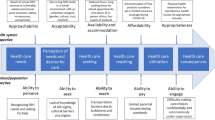Abstract
Whakapapa is the foundation of traditional Māori social structure and it perpetuates a value base that locates people through their relationships to the physical and spiritual worlds. As part of a new envirogenomics research programme, researchers at the Institute of Environmental Science and Research (ESR) are developing a study with an iwi (tribe) to identify combinations of genetic and environmental factors that may contribute to current health status. A major objective of this study is to utilise whakapapa (genealogical information) to explore patterns of genetic variation unique to the iwi and to correlate these with potential disease or ill health. Genetic testing and screening raises numerous ethical issues, particularly when indigenous peoples are the subjects. This paper will outline ESR’s strategy for addressing indigenous concerns about genetic testing and how whakapapa forms an integral part of the envirogenomics research programme.
Similar content being viewed by others
References
Williams, H. W. (1997). Dictionary of the Māori language. Wellington: GP.
Moon, P. (2003). Tohunga, Hohepa Kereopa. Auckland: David Ling.
Tipene-Matua, B. (2000). A Māori response to the biogenetic age. In R. Prebble (Ed.), Designer genes: The New Zealand guide to the issues, facts and theories about genetic engineering. Wellington: Dark Horse.
Roberts, M., Haami, B., Benton, R., Satterfield, T., Finucane, M. L., Henare, M., et al. (2004). Whakapapa as a Māori mental construct: Some implications for the debate over genetic modification of organisms. Contemporay Pacific, 16(1), 1–28.
Mead, A. T. P., & Tomas, N. (1995). The convention on biological diversity: Are human genes biological resources? NZ Env Law Reporter, 130–131. (Cited by: Waitangi Tribunal. Wai 262: Mātauranga Māori and taonga. 2001; Wellington: Waitangi Tribunal.)
O’Regan, H. (2005). Whose line is it anyway? Lineage/whakapapa, fertility and the Māori world view [presentation to the Fertility Society Australia Scientific Meeting]. NZ: Christchurch, Sept 4–7.
Durie, M. (2003). Ngā kahui pou: Launching Māori futures. Wellington: Huia.
Kukutai, T. (2003). The dynamics of ethnicity reporting: Māori in New Zealand. Wellington: Te Puni Kōkiri.
Howden-Chapman, P., & Cram, F. (1998). Social, economic and cultural determinants of health. Wellington: National Health Committee.
Ajwani, S., Blakely, T., Robson, B., Tobias, M., & Bonne, M. (2003). Decades of disparity: ethnic mortality trends in New Zealand 1980–1999. Wellington: Ministry of Health and University of Otago.
Blakely, T., Fawcett, J., Atkinson, J., Tobias, M., & Cheung, J. (2005). Decades of disparity II: Socioeconomic mortality trends in New Zealand 1981–1999. Wellington: Ministry of Health and University of Otago.
Bishop, R. (1996). Collaborative research stories: Whakawhanaungatanga. Palmerston North: Dunmore.
Smith, L. T. (1999). Decolonizing methodologies: Research and indigenous peoples. London and New York: Zed Books.
Lea, R. A., Benowitz, N., Green, M., Fowles, J., Visvanath, A., Dickson, S., et al. (2005). Ethnic differences in nicotine metabolic rate in New Zealand. NZ Med J, 118(1227), U1773, Dec 16.
O’Regan, T. (1993). Who owns the past? Changes in Māori perceptions of the past. In W. Ihimaera, H. Williams, I. Ramsden, & D. S. Long (Ed.), Te ao mārama, regaining Aotearoa: Māori writers speak out. Auckland: Reed Books.
Royal Commission on Genetic Modification (2002). Report of the Royal Commission on Genetic Modification. Wellington: Ministry for the Environment.
Smith, C., & Reynolds, P. (2000). Māori, genes and genetics: What Māori should know about the new biotechnology. Whanganui: Whanganui Iwi Law Centre.
Cram, F., Phillips, H., Tipene-Matua, B., Parsons, M., & Taupo, K. (2004). A ‘parallel process’? Beginning a constructive conversation about a Māori methodology. Journal of Bioethical Inquiry, 1(1), 14–19.
Du Plessis, R., Scott, A., Phillips, H., Cram, F., Tipene-Matua, B., Parsons, M., et al. (2004). The social, cultural, ethical and spiritual implications of genetic testing. Research report 3. Christchurch: University of Canterbury.
Cram, F., Pihama, L., & Barbara, G. (2000). Māori and genetic engineering. Auckland: International Research Institute for Māori and Indigenous Education.
Hudson, M. (2004). Māori and ethical review in health research [thesis]. Auckland: Auckland University of Technology.
United Nations Permanent Forum on Indigenous Issues. International workshop on methodologies regarding free, prior and informed consent and indigenous peoples [homepage on the Internet]. [Updated 2006; cited 2006 May 8]. Available from http://www.un.org/esa/socdev/unpfii/en/workshops.html.
Leach, M., Tamasese, K., & Fairburn-Dunlop, P. (2006). United Nations Educational, Scientific and Cultural Organisation Ethics of Knowledge Production conference [responses to Universal Declaration on Bioethics and Human Rights]. N.Z.: Dunedin, Feb 12–14.
Nelkins, D. (2002). A brief history of the political work of genetics. Jurimetrics Journal, 42, 121–132.
Collins, F. S. (2004). What we do and don’t know about ‘race,’ ‘ethnicity,’ genetics and health at the dawn of the genome era. N Genetics, 36, S13–S15.
Chaix, R., Austerlitz, F., Khegay, T., Jacquesson, S., Hammer, M. F., Heyer, E., et al. (2004). The genetic or mythical ancestry of descent groups: Lessons from the Y chromosome. American Journal of Human Genetics, 75, 1113–1116.
Petersen, A., & Bunton, R. (Eds.) (2002). The new genetics and the public’s health. London and New York: Routledge.
Author information
Authors and Affiliations
Corresponding author
Glossary
- Hapū
-
clan/sub-tribe
- Iwi
-
tribe
- Kaitiaki/kaitiakitanga
-
guardian/guardianship
- Kaupapa
-
purpose/agenda
- Kawa
-
protocol, etiquette
- Manaakitanga
-
caring, hospitality
- Māori
-
indigenous people of Aotearoa/New Zealand
- MātaurangaMāori
-
Māori knowledge
- Mauri
-
life-force, essence
- Ngāti Kahungunu
-
tangata whenua of Hawkes Bay and lower East Coast of the North Island
- Pepeha
-
a saying that can locate the speaker to a place, a region, and an ancestry
- Rakaipaaka
-
iwi of Nuhaka and Mahia peninsula, Hawke’s Bay
- Tangata whenua
-
people of the land
- Te Ao Māori
-
the Māori world
- Tikanga
-
custom, obligations and conditions
- Tūpuna
-
ancestors
- Wairua
-
spirit
- Whakapapa
-
genealogy/genealogical information
- Whakatauki
-
proverb
- Whānau
-
family
- Whanaunga/whanaungatanga
-
relative/kinship
- Whenua
-
land, placenta
Rights and permissions
About this article
Cite this article
Hudson, M.L., Ahuriri-Driscoll, A.L.M., Lea, M.G. et al. Whakapapa – A Foundation for Genetic Research?. Bioethical Inquiry 4, 43–49 (2007). https://doi.org/10.1007/s11673-007-9033-x
Received:
Accepted:
Published:
Issue Date:
DOI: https://doi.org/10.1007/s11673-007-9033-x




